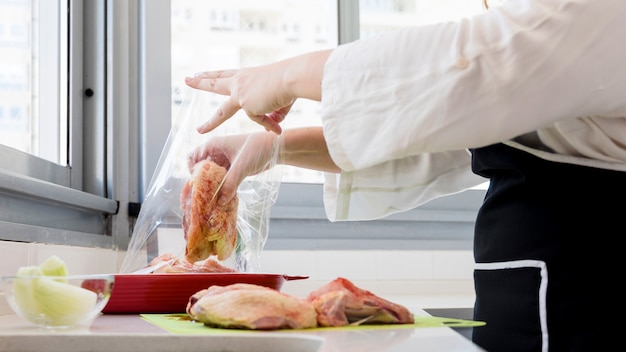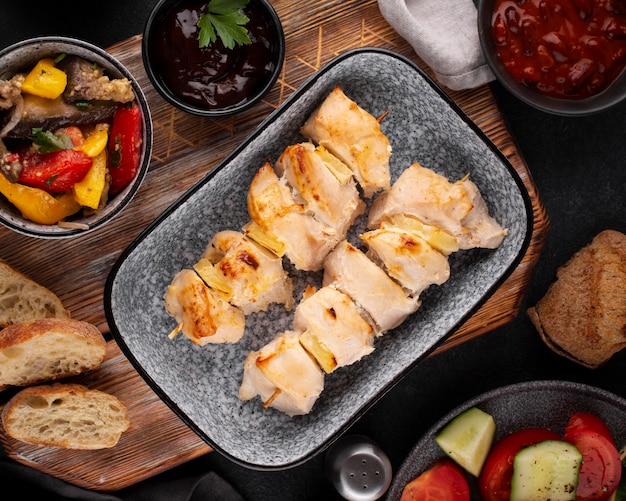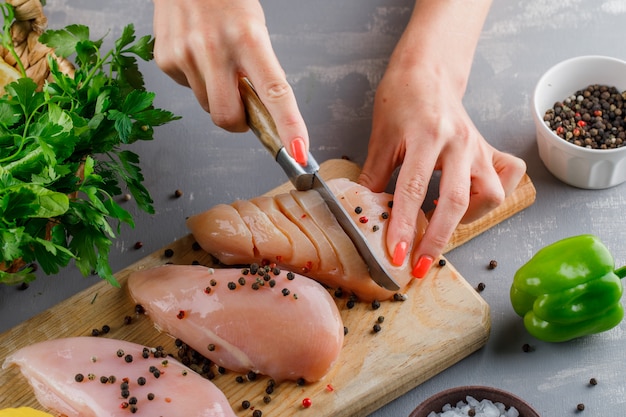Let's face it, a juicy, tender chicken breast is a culinary masterpiece. It's the kind of dish that makes you say, "Mmm, that's good!" But we've all been there, haven't we? The dry, rubbery chicken breast that makes you wonder if you've committed a culinary crime. Fear not, my fellow food enthusiasts! This guide is your ticket to consistently achieving that perfectly cooked, flavourful chicken breast. From choosing the right bird to mastering different cooking methods, we'll explore it all. And don't worry, I'll share my own experiences along the way - the good, the bad, and the downright delicious.
(Part 1) Choosing the Right Chicken Breast: It's All About the Starting Point

You know the saying, "You can't make a silk purse out of a sow's ear?" Well, it's the same with chicken. The quality of your chicken breast is the foundation for your success. So, let's get choosy!
The Look and Feel: Spotting a Winner
When you're picking out your chicken breast, you want one that's a pale, creamy colour, almost like a soft ivory. The texture should be firm and springy, not floppy or squishy. Think of it like a well-toned muscle, not a deflated balloon. Avoid any chicken that looks dry, dull, or has any strange discoloration. And steer clear of slimy bits, those are usually a sign of trouble.
Bone-in vs. Boneless: A Matter of Taste
Here's where personal preference comes in. Bone-in chicken breasts tend to hold onto moisture better, and they often have a more robust flavour. It's like the bone acts as a little moisture shield. Boneless skinless chicken breasts are definitely easier to work with, but they can be a bit more prone to drying out if you're not careful.
Size Matters: Finding the Goldilocks Chicken
You don't want a chicken breast that's so small it disappears in the pan, and you don't want one so large it takes forever to cook. The size of your chicken breast directly impacts the cooking time, so aim for medium-sized breasts. These are usually easier to manage and cook evenly.
The Chicken Farmer: Going the Extra Mile
If you can, try to buy free-range or organic chicken. These chickens are often raised with more space and access to the outdoors, and they generally have a richer flavour. Think of it as a little bit of extra pampering for the bird translates to extra flavour for you. You can usually find these options labelled clearly in the supermarket, or you can ask your butcher for their recommendations.
(Part 2) Preparing the Chicken Breast: Setting the Stage for Success

You've got your perfect chicken breast, now it's time to give it a little TLC before you start cooking. This simple prep work can make a huge difference in the final result.
Washing or Not Washing? The Great Debate
Ah, the age-old question. Some people swear by washing chicken, while others claim it's a recipe for disaster. I fall into the "don't wash it" camp, and I'm not alone! The USDA recommends against washing chicken. Washing doesn't actually get rid of bacteria, it can actually spread it around your kitchen. Think of those juicy little droplets of water splashing everywhere! The best defence against bacteria is to cook your chicken thoroughly.
Pat It Dry: A Step Worth the Effort
Whether you wash it or not, patting your chicken breast dry with kitchen paper is absolutely essential. This helps the chicken brown evenly, creating that delicious crispy skin we all love. It also prevents the chicken from steaming instead of frying, which can make it soggy and lackluster.
Salt It or Not? A Question of Timing
Here's another topic that sparks debate. Some people claim that salting chicken beforehand draws out moisture, leading to dry chicken. I'm on the other side of this argument. I believe that salting chicken in advance helps to season it more evenly and actually promotes juiciness. It's all about timing. If you salt your chicken too far in advance, the salt has a chance to draw out moisture. But, if you salt it just before cooking, you'll get the benefit of even seasoning without the moisture loss. I usually season with salt and pepper, but you can also add your favourite herbs and spices at this stage.
(Part 3) Cooking Methods: Finding Your Perfect Match

Okay, we've chosen our chicken, prepped it, and now it's time to cook! There are so many different ways to cook a chicken breast, it's like a choose-your-own-adventure story. Each method has its own advantages and disadvantages, so let's dive in and see what suits your style.
Oven-Baked: A Simple and Reliable Method
This is my go-to method for cooking chicken breast, especially when I'm cooking for a crowd. It's foolproof, effortless, and delivers consistently juicy results. No fancy equipment or complicated steps, just pure, simple goodness.
oven-baked chicken breast: Step-by-Step
- Preheat your oven to 190°C (375°F). This ensures your chicken cooks evenly and doesn't get stuck in the "raw in the middle" zone.
- Place your chicken breast on a baking sheet lined with parchment paper. This makes clean-up a breeze, trust me!
- Drizzle the chicken with olive oil. A little drizzle goes a long way, it helps the chicken brown beautifully and locks in the moisture.
- Season the chicken with salt and pepper. Don't be shy with the seasonings, let those flavours shine through.
- Roast the chicken for 20-25 minutes, or until the internal temperature reaches 74°C (165°F). This is where a meat thermometer is your best friend. It takes the guesswork out of cooking and ensures your chicken is perfectly safe to eat.
- Let the chicken rest for 5 minutes before slicing and serving. This allows the juices to redistribute, making your chicken even more tender and flavorful.
Pan-Frying: Achieving Crispy Perfection
Pan-frying is another great way to cook chicken breast. It's quick and easy, and you get that beautiful, crispy skin that makes your taste buds sing. It's the perfect choice for a weeknight dinner when you want something fast and delicious.
pan-frying chicken Breast: Step-by-Step
- Heat a large frying pan over medium-high heat. You want the pan hot enough to sear the chicken quickly and create that lovely golden-brown crust.
- Add a tablespoon of oil to the pan. Choose your favourite oil, but olive oil is a classic choice. It adds a beautiful flavour to the chicken.
- Place the chicken breast in the pan and cook for 3-4 minutes per side, or until golden brown and cooked through. Don't overcrowd the pan, give the chicken some space to brown nicely.
- Reduce the heat to low and continue cooking for another 2-3 minutes, or until the internal temperature reaches 74°C (165°F). This ensures the chicken is cooked all the way through.
- Let the chicken rest for 5 minutes before slicing and serving. The resting time is crucial for juicy, flavorful chicken.
Grilling: Outdoor Flavour and Smoky Goodness
Grilling is perfect for those summer BBQs or whenever you're craving a smoky, chargrilled flavour. It gives the chicken those beautiful grill marks that instantly elevate the visual appeal.
grilling chicken breast: Step-by-Step
- Preheat your grill to medium-high heat. You want the grill hot enough to create those perfect grill marks without burning the chicken.
- Place the chicken breast on the grill and cook for 4-5 minutes per side, or until golden brown and cooked through. Make sure to check the internal temperature to ensure it's cooked through.
- Let the chicken rest for 5 minutes before slicing and serving. Resting is just as important when grilling as it is with other methods.
Other Methods: Exploring Different Textures and Flavours
There are many other ways to cook chicken breast, including slow cooking, poaching, and steaming. These methods can be great if you're looking for a more tender chicken breast. However, they don't give you the same browning and crispy skin that you get with oven-baking, pan-frying, or grilling.
(Part 4) The Temperature Gauge: Your New Best Friend
Listen, I know it can be tempting to just "eyeball it" when it comes to cooking chicken, but trust me, a meat thermometer is your new best friend. It's the only way to truly know if your chicken is cooked through and safe to eat. The internal temperature of cooked chicken breast should reach 74°C (165°F).
(Part 5) Resting is Key: Allowing the Juices to Redistribute
I know you're probably eager to dig in as soon as the chicken is cooked, but hold your horses! Let your cooked chicken breast rest for 5-10 minutes before slicing. This allows the juices to redistribute throughout the meat, resulting in a much juicier and more flavorful chicken. It's a simple step that makes a big difference!
(Part 6) Flavour Combinations: It's All About the Sauce
Now, let's talk about flavour! A perfectly cooked chicken breast is a blank canvas, ready for your culinary masterpiece. Sauces are the finishing touch that can elevate a simple chicken breast to a truly unforgettable dish.
Saucy Inspiration: A World of Flavour Possibilities
- Lemon Herb Sauce: A classic and refreshing option. Just squeeze some lemon juice over the chicken, add chopped fresh herbs like parsley, dill, or chives, and season with salt and pepper. The brightness of the lemon cuts through the richness of the chicken, and the herbs add a fresh, vibrant flavour.
- Garlic Butter Sauce: Rich and decadent, this sauce is perfect for a special occasion or a cozy night in. Melt some butter in a pan, add minced garlic, and cook until fragrant. You can add a squeeze of lemon juice or a splash of white wine for extra flavour. The garlic adds a pungent, aromatic flavour, while the butter creates a creamy, indulgent texture.
- Honey Mustard Sauce: Sweet and tangy, this sauce is perfect for those who like a little bit of sweetness with their savoury. Mix honey and mustard together in a bowl, add a pinch of salt and pepper, and drizzle over the chicken. The honey adds a touch of sweetness, while the mustard provides a tangy bite.
- Creamy Pesto Sauce: A delicious and flavourful option, this sauce is perfect for those who love a Mediterranean twist. Mix pesto with cream and a little grated Parmesan cheese. Pour over the chicken and you've got a flavour explosion! The pesto adds a vibrant, herbaceous flavour, while the cream creates a smooth, creamy texture.
- Spicy Mango Sauce: A bit of sweetness, a touch of spice, and a hint of tang, this sauce is sure to tantalize your taste buds. Blend mango, red onion, jalape??o, lime juice, and cilantro until smooth. Add a splash of honey and a pinch of salt and pepper. The mango adds a touch of sweetness, the jalape??o provides a kick of heat, and the lime juice gives it a bright, tangy flavour.
(Part 7) Serving Suggestions: More Than Just Dinner
Let's break free from the traditional dinner plate! Perfectly cooked chicken breast is incredibly versatile. It can be the star of your lunch, a key ingredient in a tasty snack, or even the perfect addition to a weekend brunch.
Lunchtime Options: Quick and Easy Deliciousness
- chicken salad Sandwiches: Combine shredded chicken with mayonnaise, chopped celery, onion, and herbs. Spread on toasted bread for a quick and delicious lunch. You can add a little crunch with some chopped walnuts or pecans.
- Chicken Caesar Salad: A classic combination. Toss romaine lettuce with grilled chicken, Caesar dressing, Parmesan cheese, and croutons. This is a satisfying and flavourful lunch that's easy to assemble.
- Chicken Wraps: Add shredded chicken to a tortilla with your favourite fillings like lettuce, tomatoes, avocado, and salsa. These are perfect for a quick and portable lunch. You can also add a dollop of sour cream or a sprinkle of cheese for extra flavour.
Dinnertime Delights: From comfort food to culinary adventures
- Chicken Stir-Fry: A quick and easy dinner. Stir-fry chicken breast with your favourite vegetables and sauce. Serve over rice or noodles. This is a great way to use up leftover vegetables and create a healthy and delicious meal.
- Chicken Curry: Combine chicken breast with a creamy coconut curry sauce, vegetables, and spices. This is a flavourful and comforting dish that's perfect for a cold night.
- Chicken Pot Pie: A comforting and hearty meal. Fill a pie crust with cooked chicken, vegetables, and a creamy gravy. This is a classic dish that's sure to please everyone at the table.
- Chicken Enchiladas: A Mexican classic. Fill tortillas with cooked chicken, cheese, and your favourite toppings. These are a fun and flavourful way to enjoy chicken breast.
Beyond the Plate: Thinking Outside the Box
- Chicken Pizza: Add cooked chicken to your favourite pizza toppings. This is a great way to add protein and flavour to your pizza.
- Chicken Salad: Mix shredded chicken with mayonnaise, celery, onion, and herbs for a simple and refreshing salad. You can add a little crunch with some chopped nuts or dried cranberries.
(Part 8) Leftovers: Don't Waste It!
Got leftovers? Don't throw them away! leftover chicken breast is a culinary gold mine, just waiting to be transformed into something new and delicious.
- Chicken Soup: Add shredded chicken to a pot of vegetable broth with noodles, rice, or barley. This is a comforting and nourishing soup that's perfect for a cold day.
- Chicken Salad: Use shredded chicken for a classic chicken salad sandwich or a side salad. This is a quick and easy way to use up leftover chicken.
- Chicken fried rice: Add chopped chicken to fried rice for a quick and easy meal. This is a great way to use up leftover rice and create a flavorful dish.
- Chicken Quesadillas: Combine shredded chicken with cheese, salsa, and other toppings for a delicious quesadilla. This is a perfect snack or light meal.
- chicken tacos: Use shredded chicken for tacos, burritos, or bowls. This is a fun and flexible way to use up leftover chicken.
(Part 9) Chicken Breast Storage: Keeping It Fresh and Safe
Proper storage is essential for keeping your chicken breast fresh and safe to eat. Here's what you need to know:
- Refrigerator Storage: Store uncooked chicken in the refrigerator for up to 2 days. Make sure to keep it wrapped well to prevent cross-contamination.
- Freezer Storage: You can freeze chicken breast for up to 2 months. Wrap it tightly in plastic wrap or freezer paper to prevent freezer burn.
(Part 10) FAQs: Answering Your Chicken Questions
What are the best herbs and spices for chicken breast?
That's a great question, and it really comes down to personal preference. I love using a combination of herbs and spices, like garlic powder, onion powder, paprika, oregano, and thyme. For a bit of heat, I'll often add some cayenne pepper or chili flakes. But don't be afraid to experiment! Try different combinations of herbs and spices to find what you like best.
Can you cook chicken breast in the microwave?
Technically, you can cook chicken breast in the microwave, but I wouldn't recommend it. microwave cooking can often result in unevenly cooked chicken. The outside might be cooked through, but the inside could still be raw. It's best to stick with other methods like oven-baking, pan-frying, or grilling for consistently cooked chicken.
How do you prevent chicken breast from drying out?
The key to preventing chicken breast from drying out is to not overcook it. Use a meat thermometer to ensure that the chicken breast is cooked to an internal temperature of 74°C (165°F). And always remember to let the chicken rest for a few minutes after cooking. This helps the juices redistribute, resulting in a juicier chicken breast.
How long does it take to cook a chicken breast?
The cooking time for a chicken breast will vary depending on the size and the cooking method you're using. Generally, it will take around 20-25 minutes for a medium-sized chicken breast cooked in the oven. For pan-frying or grilling, it will take around 5-7 minutes per side. But always check the internal temperature to ensure the chicken is cooked through.
What are some healthy ways to cook chicken breast?
Chicken breast is already a relatively healthy option, but you can make it even healthier by choosing cooking methods that don't require a lot of fat. For example, you can bake, grill, or poach chicken breast. Avoid cooking with too much oil or butter. You can also try marinating the chicken breast in a low-fat marinade for extra flavour and moisture.
There you have it, my friends! Armed with this knowledge, you are ready to conquer the world of chicken breast. So, go forth and cook! And remember, if you're ever feeling lost or unsure, come back to this guide and I'll be here to help you every step of the way. Happy cooking!
Everyone is watching

Corn on the Cob: The Ultimate Guide to Perfectly Cooked Ears
Healthy MealsAh, corn on the cob. Just the name evokes images of sunny days, barbecues, and that sweet, juicy flavour that ...

Perfect Pork Roast Oven Cooking Time: A Guide to Delicious Results
Healthy MealsThere's something truly satisfying about a perfectly roasted pork. The aroma alone is enough to make your mout...

Ham Cooking Time: How Long to Bake, Smoke, or Boil a Delicious Ham
Healthy MealsAh, ham. It's a classic, isn't it? A real crowd-pleaser, especially around holidays. And when done right, it'...

Scallops: The Ultimate Guide to Perfect Cooking
Healthy MealsAh, scallops. Those delicate, sweet, and utterly delicious morsels of the sea. They hold a special place in my...

Spaghetti Squash: The Ultimate Guide to Cooking and Serving
Healthy MealsRemember that time you saw spaghetti squash at the supermarket, looking all bumpy and strange, and thought, "W...
